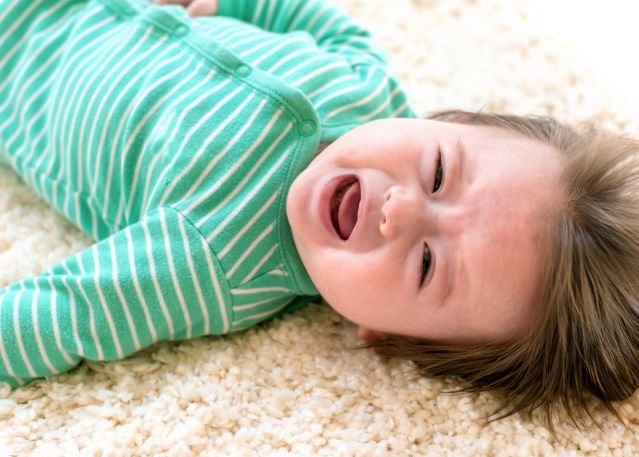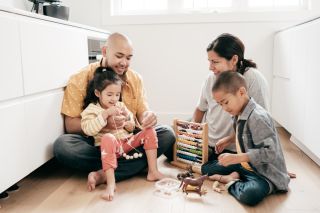Emotion Regulation
How to Help Challenging Children Identify and Manage Their Feelings
Parents can use playtime to teach social skills and emotional regulation.
Posted December 20, 2022 Reviewed by Abigail Fagan
Key points
- Children need to learn how to cope with disappointment; such knowledge makes it easier to take risks in life.
- Knowing that they can manage and cope with unpleasant emotions enables kids to face difficult situations with less anxiety and discomfort.
- Parents are critical teachers of their children, showing them how to express and deal with unpleasant emotions.
Several skills we developed in childhood helped us ease into adulthood. One of these was the ability to regulate our emotions. But we didn't all master this skill at the same rate, nor do we all manage our emotions to the same degree. Even as adults, we know people who seem annoyed by the smallest inconveniences and others who seem to take challenging situations in stride.
The development of emotional regulation begins when we are very young. Infants cry to express their needs, and adults must figure out what they are crying about. Even when your children were too young to respond, you might have asked them questions: Are you hungry? Do you need me to change you? Although you knew they could not answer, you were modeling the expression of a need for them so they could ask for your help themselves down the road.

Over time, our life experiences have given us practice dealing with our emotions. With the coaching of our caregivers, we learned how to label our feelings with greater specificity. Feeling "upset" became more nuanced: frustrated, angry, disappointed, envious, or disgusted. We also learned how to interpret situations by paying attention to the comments or behavior of others, especially those we admired or felt close to. We learned how to soothe ourselves when we become upset, though, not surprisingly, our temperaments can either intensify or mitigate our emotional responses.
So, how can parents teach their children how to identify, express, and regulate their emotions in a healthy way? My recommendations are based in part on the work of Carolyn Webster-Stratton, a clinical psychologist who, for many years, was on the faculty at the University of Washington, Seattle, and ran a classroom for children with challenging temperaments.

First, set aside time each day to play with your children. Playtime builds relationships and provides a platform for you to encourage them, particularly in areas needing further development, such as school-readiness skills, social and interpersonal skills, and emotion labeling and regulation. Webster-Stratton recommends 30 minutes daily to be effective.
- If 30 minutes a day is not possible because of other parental demands, then pick a shorter length of time to which you can commit daily. The goal is consistency and predictability. You don't want to create an expectation that inadvertently leads to your children misbehaving to get your attention.
- If possible, aim for the same time each day, so your children have no need to act out because they don't know exactly when they will get your attention.
- When you interact with your children during this playtime, allow them to take the lead. Imitate their play. Add to it rather than change it. Provide a running narrative of what they are doing that positively highlights the skill sets you are trying to develop, such as self-confidence, persistence, emotional regulation, coping, and so forth.
- Because you are specifically trying to cultivate emotional awareness and regulation in your children, it is important to give praise for evidence of both, even when they are not doing things perfectly. You are praising them for steps in the right direction—for example, appearing distressed but not throwing the toy they were playing with, as they may have done in the past.
- Be careful not to offer corrective feedback inadvertently. (No, that puzzle piece doesn't go there, it goes here.) Comments like these can unintentionally promote perfectionism and anxiety—even helplessness when the desired goal is not easily reached. Also, avoid combining praise with put-downs. (You're doing such a good job doing X, not like you usually do…)
- Think of child-directed playtime as one where your children direct the activity, and you use what they do as the basis for coaching them in those skills they are developing. The activities in which they are engaged are irrelevant. You are focused for the entire period on your children and their actions and reactions. Your commentary is positive and calls attention to approximations or accomplishments of desired behaviors.
- During this playtime, teach your children how to praise themselves by saying things like, "You must feel proud of yourself for doing X." When they whine, yell, or throw toys, ignore the behavior if possible and try to divert them with a different toy. If this is unsuccessful, say, "When you throw the blocks, we need to stop playing." After they return to appropriate play, redirect your attention towards them.
- It's also important to prepare children for the end of the play session with a statement like, "In a few minutes, I will have to stop playing with you. I really enjoyed doing this today." Ignore pleading, protests, and arguments. You can also add that you will play with them again tomorrow.
Outside of this playtime, you want to communicate many of the same messages to your children but in a less focused way—not paying as close attention to every action. Here, though, you are noticing their behavior—especially behavior you want to encourage—rewarding them with praise (I like the way you're playing quietly), indirectly teaching them, and integrating these social-emotional lessons into daily activities. Whenever possible, make your praise immediate and specific. Give your children a road map for getting positive praise again that shows them exactly what they need to do. The more challenging your children are, the more you want to praise them for approximations of the goal behavior you want them to repeat.

When other kids come over to play with your kids, you can teach and model how to praise others: Look at what Tyra made! Can you give her a compliment? And, because children are prideful, be sure to praise yours in front of others when appropriate.
This set of strategies, like any other, won't result in a 180-degree turnaround in your children's behavior overnight, but most parents do notice changes even in a week's time. The value of a 30-minute-a-day investment to produce such significant positive change is also an investment in their futures. You are not only equipping your children to better navigate today and tomorrow; you are giving them tools they will use for the rest of their lives to navigate their futures with less distress and more autonomy.
Because we learn as much from watching others as from interacting with them, it should come as no surprise that COVID has stunted the social-emotional growth of many children. The precautions we took to avoid contracting the virus resulted in fewer real-life learning opportunities for kids. Even before COVID, we saw many academically high-achieving students struggling to navigate life successfully. Pre-COVID, it was estimated that about 20 percent of children who did not meet the criteria for a diagnosable issue exhibited challenging behavior.

Teaching children how to label what they are experiencing, to take others' perspectives, to soothe themselves with self-talk, and to rethink whether an event is truly catastrophic are all tools that can be taught in your interactions with your children. These tools will begin to be honed in childhood and evolve—serving them well into adulthood.




